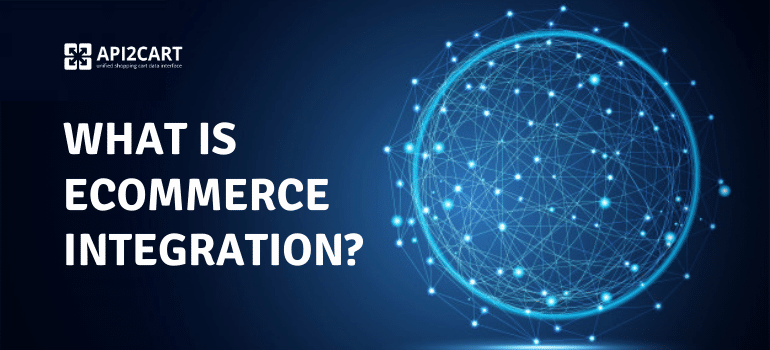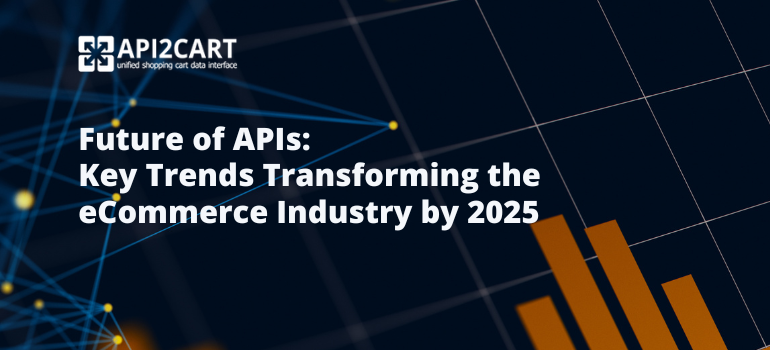
Running SaaS for eCommerce businesses? Then, developing eCommerce integration is a must-have for your solution. The more integrations with eCommerce platforms you support, the better are the chances to attract new clients.
This article explores the top eCommerce platforms for connection and the challenges associated with building custom integrations. We'll also introduce API2Cart, a unified API solution that simplifies the integration process, saving you time and resources.
What is eCommerce Integration?
eCommerce integration is a process of connecting different software and platforms used in online selling. As a result, this integration enables smooth data sharing, making business operations simpler and faster.
For eCommerce software providers this integration means linking their software or applications to shopping platforms and marketplaces. eCommerce data integration facilitates the exchange of critical store information, such as product details, customer data, orders, shipments, and shopping carts.
For example, if you are running a repricing software and your clients base their e-stores on Shopify, you need to be able to get the price info from Shopify. Without the integration with Shopify and access to such kind of data, your software won't be able to update prices on Shopify online stores and do the other essential operations.
As you can see, no matter what kind of software for online retailers you provide, you have to develop the connection with shopping platforms that your clients use.
Benefits of eCommerce Integration for Software Providers?
Have you ever thought about how critical eCommerce integrations are for your eCommerce software? Here’s why it's important to have integrations with multiple shopping platforms.
Competitive advantage
You are probably always keeping an eye on your competitors to see what new features they offer. It’s very important to stay one step ahead of them. That’s why developing new eCommerce integration can really help your eCommerce software stand out and keep you ahead in the competition.
Access to a Larger Market
The more eCommerce integrations your solution supports, the more clients you reach. For instance, WooCommerce powers over 30% of all online stores, while Magento accounts for 26% of the global eCommerce market. Integrating with these and other popular shopping platforms can increase your chances of getting new customers and boosting revenue.
Flexibility for Your Clients
Multi-platform integrations help clients manage all store data centrally, ensuring accurate data and inventory levels across different sales channels.
If you offer shipping, email automation, order management, or ERP systems, eCommerce integration is essential.
Let's take a closer look at the most popular eCommerce platforms for integration, according to API2Cart research.
which platforms to integrate with which for eCommerce?

Shopify eCommerce platform
Shopify claims to be the best and secure shopping platform. The number of active stores running on this platform is over 5.6 million. Primarily, this eCommerce platform is highly popular in the USA (more than 1,000,000 stores).
Shopify provides high-quality service at an affordable price. Store owners choose it for built-in marketing tools, tech support, flexibility in setup, and access to automatic shipping rates. Shopify supports more than 50 languages.
The connection of your app with Shopify means that you will be able to boost your clients' number several times. Also, it's a good option if you are targeting the USA market.
However, there is a significant number of challenges connected with this process. For example, the integration with Shopify takes approximately one month. Also, Shopify releases its new API version every three months, and the changes can affect your software integration with this platform.
Etsy eCommerce platform
Etsy is a popular eCommerce platform, especially among the dropshippers. The main clients of this shopping platform are those who sell vintage items and handmade crafts. Etsy allows uploading up to five images for each item and adding videos. It provides detailed statistics to its clients.
According to Statista, more than 5.6 million sellers from 234 countries sell their goods through this platform.
Even though, Etsy API provides an easy-to-use RESTful interface, the eCommerce platform integration with it takes from 4 to 6 weeks. It also requires the help of highly experienced professionals.
WooCommerce eCommerce platform
WooCommerce powers about more than 30% of all the online stores. It is an open-source eCommerce platform with a customer base of 4.6 million. WooCommerce is built on WordPress and provides free and paid extensions. It allows selling different types of goods, from physical products to content and appointments.
WooCommerce has a few API versions. What does it mean for you as a software provider? Every time a new version of this eCommerce platform appears, you need to make the changes in your code. Consequently, it requires a lot of time and effort. It is hard to develop the integration with the oldest and the newest WooCommerce APIs at once. However, it is a must-have as e-store owners that are using the earliest WooCommerce versions may have not a desire to upgrade. So, if you are willing to satisfy all WooCommerce e-store owners, you need to have a smooth connection with all its API versions.
OpenCart platform
With seven years of experience and 211,000 satisfied store owners, OpenCart proves to be one of the best solutions for online retailers. This eCommerce platform has a huge success in the USA (48,000 stores), Russia (43,000 stores), and the Ukraine (17,000 stores). The main features of OpenCart: free download and updates, built-in SEO, over 13000 modules and themes, multiple payment gateways.
The integration of your app with OpenCart will require considerable expenses and detailed learning of its architecture. This platform has a significant number of versions.
Magento eCommerce platform
Covering 26% of all the online stores across the world, Magento allows you to reach out to more than 129,000 potential clients. Magento is an open-source platform. It offers customizable design, a vast number of product attributes, product comparison, etc.
The difficulties in integration with Magento are connected with EAV (Entity-Attribute-Value) database model, 60+ various tables with info on products and categories, data import issues, the inaccuracy of API documentation.
PrestaShop eCommerce platform
PrestaShop allows building online shops very quickly. It enables to use multiple payment options and detailed analytics. PrestaShop supports 45+ languages. This shopping platform is easy to set up and use. Nowadays, more than 184,000 store owners use Prestashop.
Here are the countries that use PrestaShop platform the most: Spain, the United Kingdom, the United States of America, Australia, and Canada.
The integration with PrestaShop allows you to increase the number of your clients and expand your software sales throughout the world.
BigCommerce platform
BigCommerce is an all-in-one eCommerce platform. It is popular among growing businesses and startups. More than 39,000 online stores from 65 countries are based on the BigCommerce platform. This shopping platform provides customizable design themes, professional SEO tools, abandoned cart saver, and multiple payment options.
BigCommerce has detailed API documentation. However, the process of integration with it is not as easy as you can think. It requires strong technical experience and expertise.
CS-Cart eCommerce platform
CS-Cart rules over the eCommerce market for about 13 years. More than 10,000 eCommerce stores are built on this platform. CS-Cart has a drag-and-drop user interface that is highly appreciated by its customers. It provides a wide variety of themes and various payment methods.
CS-Cart has a mobile application for Android and iOS systems. Also, it provides the possibility to use its multilingual and multi-currency functionality.
CS-Cart has a RESTful API and four methods to view and modify objects: Get, Put, Post, Delete. It provides detailed API documentation available for experienced developers.
Why Custom Integration is Challenging
The manual construction and maintenance of integrations with eCommerce platforms can be a huge burden for software vendors. Although integrations are a necessity for adding value to retailers, the manual approach to integrations has a lot of technical and business-related challenges:
Custom eCommerce integration requires significant expertise and engineering time. Since each platform has its own API structure and logic, development may take weeks or months and push your product roadmap back.
eCommerce platforms often update APIs, data formats, or authentication methods. Manually integrated systems require frequent monitoring and updates to remain compatible, which consumes the developer resources and maintenance costs.
Issues It is not scalable to add new integrations by hand one at a time. As your customer base increases and other platforms are demanded, you may always be lagging behind in the integration requirement.
Different platforms organize their data in a different way. It is complex and error-prone to align the product types, the order statuses, the inventory logic, or the customer records in different systems. The standardization of the data handling makes it hard for one to provide consistent functionality.
Manual integrations hinder your speed of new feature launch or supporting new platforms. This affects your competitiveness and your capacity to be agile in meeting the market demands.
Starting from scratch increases bugs, especially with complex platforms or large data. Any downtime or syncing issues can ruin the reputation of your software and cause harm to the businesses of your clients.
When your developers are spending their time trying to manage integrations, they're not working on making your core features better. This limits innovation and makes differentiation harder in a competitive market.
API2Cart - the Best eCommerce Integration Service
There are multiple eCommerce platforms your software can integrate with. However, if you want to succeed in the B2B software market and expand the number of your potential customers, we recommend developing eCommerce platform integration with the ones we’ve listed above.
How API2Cart Simplifies eCommerce Integration
You must keep in mind that the process of integration involves technological complexity, a huge budget, and months of your developers’ work. However, you can try one of the best eCommerce integration services that will help you to overcome such difficulties.
API2Cart provides a unified API for integration with more than 60 eCommerce platforms at once. This list includes Shopify, WooCommerce, Magento, OpenCart, PrestaShop, and other popular platforms. All you need to do is to connect your app with API2Cart and enjoy the result.

You will be able to work with all the data required from your clients’ stores. It includes managing the information connected with products, orders, shipments, customers, baskets, etc.
Here is an example of how API2Cart return the data on products for Magento:
{
"return_code": 0,
"return_message": "string",
"pagination": {
"previous": "string",
"next": "string",
"additional_fields": {},
"custom_fields": {}
},
"result": {
"products_count": 0,
"product": [
{
"id": "string",
"type": "string",
"u_model": "string",
"u_sku": "string",
"name": "string",
"description": "string",
"short_description": "string",
"price": 0,
"advanced_price": [
{
"id": "string",
"value": 0,
"avail": true,
"group_id": "string",
"quantity_from": 0,
"start_time": {
"value": "string",
"format": "string",
"additional_fields": {},
"custom_fields": {}
},
"expire_time": {
"value": "string",
"format": "string",
"additional_fields": {},
"custom_fields": {}
},
"additional_fields": {},
"custom_fields": {}
}
],
"cost_price": 0,
"quantity": 0,
"inventory": [
{
"warehouse_id": "string",
"quantity": 0,
"in_stock": true,
"priority": 0,
"additional_fields": {},
"custom_fields": {}
}
],
"group_items": [
{
"child_item_id": "string",
"product_id": "string",
"default_qty_in_pack": "string",
"is_qty_in_pack_fixed": true,
"price": 0,
"additional_fields": {},
"custom_fields": {}
}
],
"u_brand_id": "string",
"u_brand": "string",
"categories_ids": [
"string"
],
"stores_ids": [
"string"
],
"url": "string",
"seo_url": "string",
"meta_title": "string",
"meta_keywords": "string",
"meta_description": "string",
"avail_sale": true,
"avail_view": true,
"is_virtual": true,
"is_downloadable": true,
"weight": 0,
"weight_unit": "string",
"sort_order": 0,
"in_stock": true,
"on_sale": true,
"backorders": "string",
"manage_stock": "string",
"is_stock_managed": true,
"create_at": {
"value": "string",
"format": "string",
"additional_fields": {},
"custom_fields": {}
},
"modified_at": {
"value": "string",
"format": "string",
"additional_fields": {},
"custom_fields": {}
},
"tax_class_id": "string",
"special_price": {
"value": 0,
"avail": true,
"created_at": {
"value": "string",
"format": "string",
"additional_fields": {},
"custom_fields": {}
},
"modified_at": {
"value": "string",
"format": "string",
"additional_fields": {},
"custom_fields": {}
},
"expired_at": {
"value": "string",
"format": "string",
"additional_fields": {},
"custom_fields": {}
},
"additional_fields": {},
"custom_fields": {}
},
"tier_price": [
{
"qty": 0,
"price": 0,
"additional_fields": {},
"custom_fields": {}
}
],
"group_price": [
{
"id": "string",
"group_id": "string",
"price": 0,
"store_id": "string",
"quantity": 0,
"start_time": "string",
"expire_time": "string",
"additional_fields": {},
"custom_fields": {}
}
],
"images": [
{
"id": "string",
"http_path": "string",
"file_name": "string",
"mime-type": "string",
"size": 0,
"create_at": {
"value": "string",
"format": "string",
"additional_fields": {},
"custom_fields": {}
},
"modified_at": {
"value": "string",
"format": "string",
"additional_fields": {},
"custom_fields": {}
},
"alt": "string",
"avail": true,
"sort_order": 0,
"type": "string",
"additional_fields": {},
"custom_fields": {}
}
],
"product_options": [
{
"id": "string",
"product_option_id": "string",
"name": "string",
"description": "string",
"sort_order": 0,
"type": "string",
"required": true,
"available": true,
"used_in_combination": true,
"option_items": [
{
"id": "string",
"product_option_item_id": "string",
"name": "string",
"sort_order": 0,
"price": "string",
"weight": "string",
"quantity": 0,
"type_price": "string",
"sku": "string",
"is_default": true,
"additional_fields": {},
"custom_fields": {}
}
],
"additional_fields": {},
"custom_fields": {}
}
],
"u_upc": "string",
"u_mpn": "string",
"u_gtin": "string",
"u_isbn": "string",
"u_ean": "string",
"related_products_ids": [
"string"
],
"up_sell_products_ids": [
"string"
],
"cross_sell_products_ids": [
"string"
],
"dimensions_unit": "string",
"width": 0,
"height": 0,
"length": 0,
"discounts": [
{
"id": "string",
"name": "string",
"modifier_type": "string",
"value": 0,
"from_time": "string",
"to_time": "string",
"customer_group_ids": "string",
"sort_order": 0,
"additional_fields": {},
"custom_fields": {}
}
],
"additional_fields": {},
"custom_fields": {}
}
],
"additional_fields": {},
"custom_fields": {}
},
"additional_fields": {},
"custom_fields": {}
}
Moreover, you won't need to deal with the shopping platform integration support and maintenance, as API2Cart takes care of this.
Benefits of Using API2Cart for Your Software
Here's how API2Cart streamlines the integration process:
- Single Integration Point: Connect your software once to API2Cart and access data from all supported platforms.
- Reduced Development Time: No need to build and maintain custom integrations for each platform.
- Simplified Maintenance: API2Cart handles API updates and platform changes, freeing up your resources.
- Extensive Functionality: Manage product information, orders, customers, and more across all connected platforms.
- Tech Support: Get expert assistance whenever you need it.
API2Cart has more than 100 API methods, detailed API Docs, and customer support. Integration with eCommerce platform via API2Cart can bring a lot of benefits for shipping, inventory, warehouse, repricing, marketing automation, and other software vendors.
By using API2Cart - eCommerce integration service you simplify integration, speed up time-to-market, and concentrate on developing value-added features for your customers as we will take care of the issues of multi-platform connectivity. Additionally, we offer over 100 API methods for effortless data management regarding products, orders, customers and other data. Importantly, our pricing is flexible and affordable. Getting started with API2Cart is simple: register for your free 14 day trial account and see how easy you can solve integration pains.
.FAQs
This powerful and reliable approach also enables eCommerce software providers to integrate their SaaS with multiple eCommerce platforms by using single API integration that simplifies their operations and provides smooth data synchronization across different eCommerce systems.
With API2Cart, you get unified error handling and detailed logs across 60+ eCommerce platforms and marketplaces, including Shopify, Magento, WooCommerce, Etsy, Wix, BigCommerce , Shopee, Flipkart, Temu, TikTok Shop, and others, at once - all through a single integration, so your SaaS team can pinpoint issues faster without digging into every platform separately.



